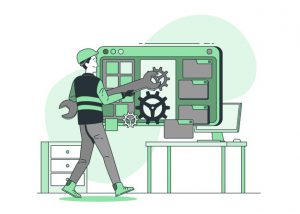Imagine someone didn’t understand the full functionality of what your app did; how long would it be before they stop using it altogether? The faster people can learn to use your app, the more likely they are to stay on it. But how can you determine whether users can easily understand and operate your application?
The definitive test to do is usability testing. Usability testing (UX testing) is a non-functional testing method that measures how easily end–users can use the software. This testing is crucial because even though the app designers know the product, they can’t say if the website presents it properly to the final users. Besides, the project team may understand the software, but external customers might not. Seemingly straightforward steps for you can be extremely difficult for the user.
Therefore, this post will discuss the advantages and disadvantages of usability testing. Understanding these benefits—and some challenges—will help you develop a user-centered solution geared toward creating a positive experience for your customers. It should be mentioned that our client’s primary purpose for usability testing services is to garner the data needed to identify usability issues and improve their website or app’s design.
When is It Necessary to Do Usability Tests?
Usability tests are usually performed in the first stage of the design phase during the development cycle. When done early, you can start troubleshooting any problems sooner, ultimately reducing the cost to resolve them. The longer you wait to run a usability test, the more the problem “soaks” into the design, and the more difficult it will be to eliminate it over time. Also, the problems could become rather expensive to fix.
Let’s think of an online store as an example.
In online stores, the transaction process is usually the main bottleneck. As a result, we need to figure out some usability issues, the areas with low user activity and low conversion rates. We employ a QA engineer to conduct usability testing and help find the problems. From the test outcome, we can understand why users ignore some areas of a page or what they don’t understand: Maybe some transaction steps are incomprehensible or too complicated for them.
Simultaneously, we can devise appropriate solutions to the problems. This could be as little as placing a button where users can quickly locate it.
Why is a Usability Test So Important?
Usability testing is essential for several reasons. First of all, it involves users in the design process. You can see how the solutions you’re developing work in practice.
Second, stakeholders can see how the user handles the product. During the tests, you can understand the good and bad sides of the software. You gain insights into how the users use your application — do they use it as intended? Do they experience many difficulties while using the app?
Another benefit of usability testing is that it provides the possibility to increase the product’s efficiency before launch. By collecting reliable user opinions and identifying their challenges, the project team gets more creative with new solutions and relevant improvements to the current system.
What Parameters Are Tested in Usability Testing?
In software testing, measuring and comparing results is indispensable if we want to create high-quality apps. We can not rely solely on our instincts and go with the flow. That is why specific parameters are monitored during usability testing. Some of them include:
- Ease of Use: We check if the software is learnable. For instance, how long will it take for the users to complete simple tasks the first time they come into contact with it?
- Efficiency: Here, we check how users who already know the product cope with it. Does it solve their problems? Does the software solution deliver real value?
- Memorability: After a break from interacting with the app, how easily can users remember its operation? We can obtain this information by carrying out usability testing.
- Error tolerance: This parameter estimates how many errors users encounter while using the app. Also, if the same errors recur frequently, how users deal with them
- Satisfaction: Testers try to ascertain the app’s appeal to the users. Assessment of a user’s attitude towards using the software tells if the application satisfies the user’s needs and if some areas can be improved.
- Content: One of the useful parameters covered by usability testing is content. Ensuring that all data relayed in the app is accurate and up-to-date, is vital. From the site/app content, and inserted links, to the contact information, everything presented to the user must be on point.
Usability Testing Pros and Cons
If you’re considering usability testing, then you should think of both the advantages and disadvantages, before making a decision.
Let’s start with the former.
Advantages of Usability Testing
Usability testing helps us do the following:
Discern Customers’ Needs and Concerns
Usability testing helps understand the client’s needs and what frustrates them while using the software. Discerning these needs and concerns could pivot the team towards building a more user-targeted application.
Meet the User’s Expectations
Usability tests confirm whether or not the product aligns with the actual expectations of the users. For example, a banking app should maximize resources to flawlessly make or receive payments, which is the one thing your users expect from it. If the software fails on this specific purpose, it’s irrelevant to the users; as such falls back on meeting their expectations.
Improve Users’ Experience
What are people’s perceptions of the utility, ease of use, and efficiency of your software product? Are they motivated to explore it further or feel the need to run off to alternative apps? Assisting us in answering these questions to improve how a user interacts with and experiences a product is one of the significant advantages of usability testing.
Discover Hidden Issues
Through usability testing, we uncover anomalies that would be difficult to detect under other conditions. For example, you can determine why the user completely ignores certain essential page elements through usability testing. You could pick up minor errors, such as a broken link, incorrectly displayed image, or button that may affect the convenience and functionality of the site/app.
Ensure the App’s Functionality Matches the Requirements
On the one hand, an efficient system needs to meet the customer needs; on the other, it should match the business specifications. For example, if the business requirement is for users to put their emails in the first field of the subscription page and their passwords in the second field, we should ensure that they can fill these fields accordingly. In other words, do these features function as intended? We can find out their capabilities during usability testing.
Disadvantages of Usability Testing
Although there are considerable advantages of usability testing, you should still keep some disadvantages in mind. These include:
Selecting a Target Group Can be Tricky
Usability testing is usually done on a sizable audience. Suppose you have built an app for 2 – 5-year-olds; it will be hard to find target users of that age range to test with.
Usability Tests are Difficult to Run
As a non-functional test, usability testing needs mostly a manual test approach to realize. This makes it much more tedious to conduct than if the tests were automated. The QA team usually puts lots of time and effort into testing and analyzing the test data.
It is Expensive
Usability tests have a broad scope and take an extended period to perform. This means a bigger budget and essentially higher costs for the organization.
Usability Test Outcomes are Arguable
Since users are selected randomly and the testing is not 100% representative of real-life experiences, the test outcome may be compromised. To get correct results, all the participants will have to report reasonable and accurate inputs, which is unrealistic.
Is Your App Easy to Use?
There are many things to consider when it comes to assessing ease of use, making it impossible to judge an app at face value alone. For example, can you tell how quickly a user can find your customer service contact information by merely looking at your website?
Of course, a good user interface should be maximized to allow that information to be found in as few clicks as possible. Still, it requires usability testing to estimate how easily users follow through on.
While there are innumerable advantages of usability testing, it’s imperative to know which testing approach – manual or automation, will rightly suit. Consider reading our blog post on manual vs automation testing, where we unraveled their differences and the best times to choose them for your project.









